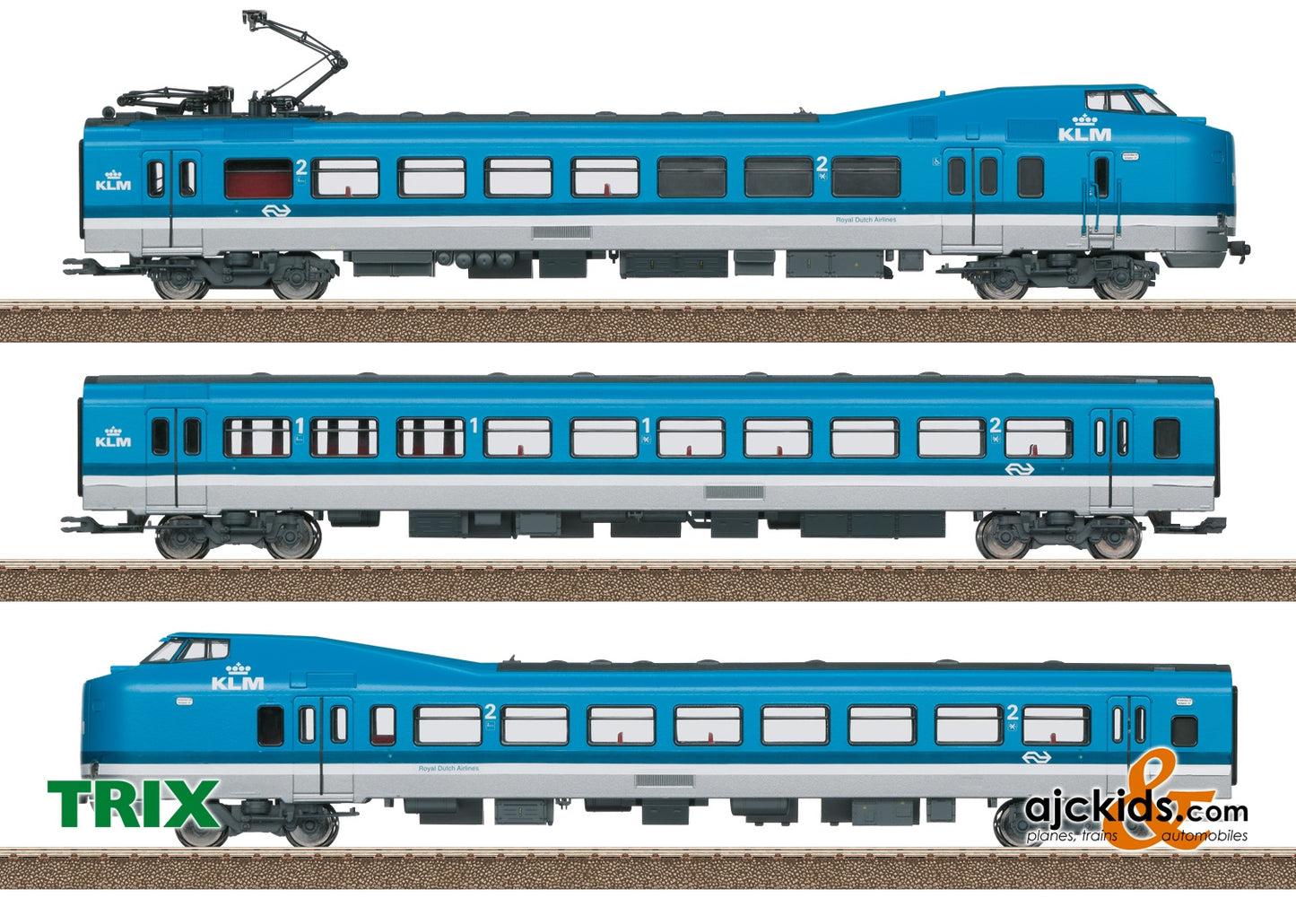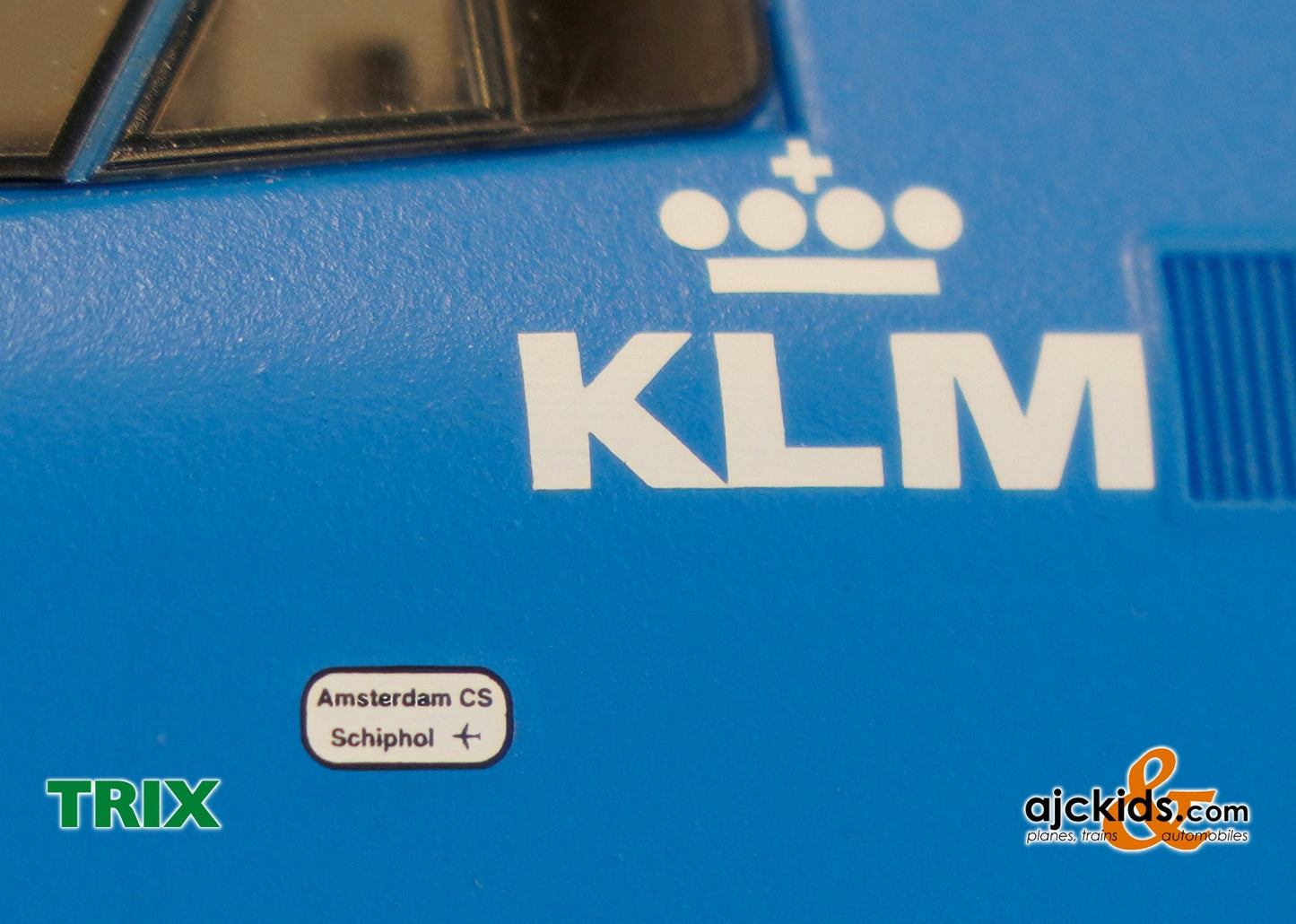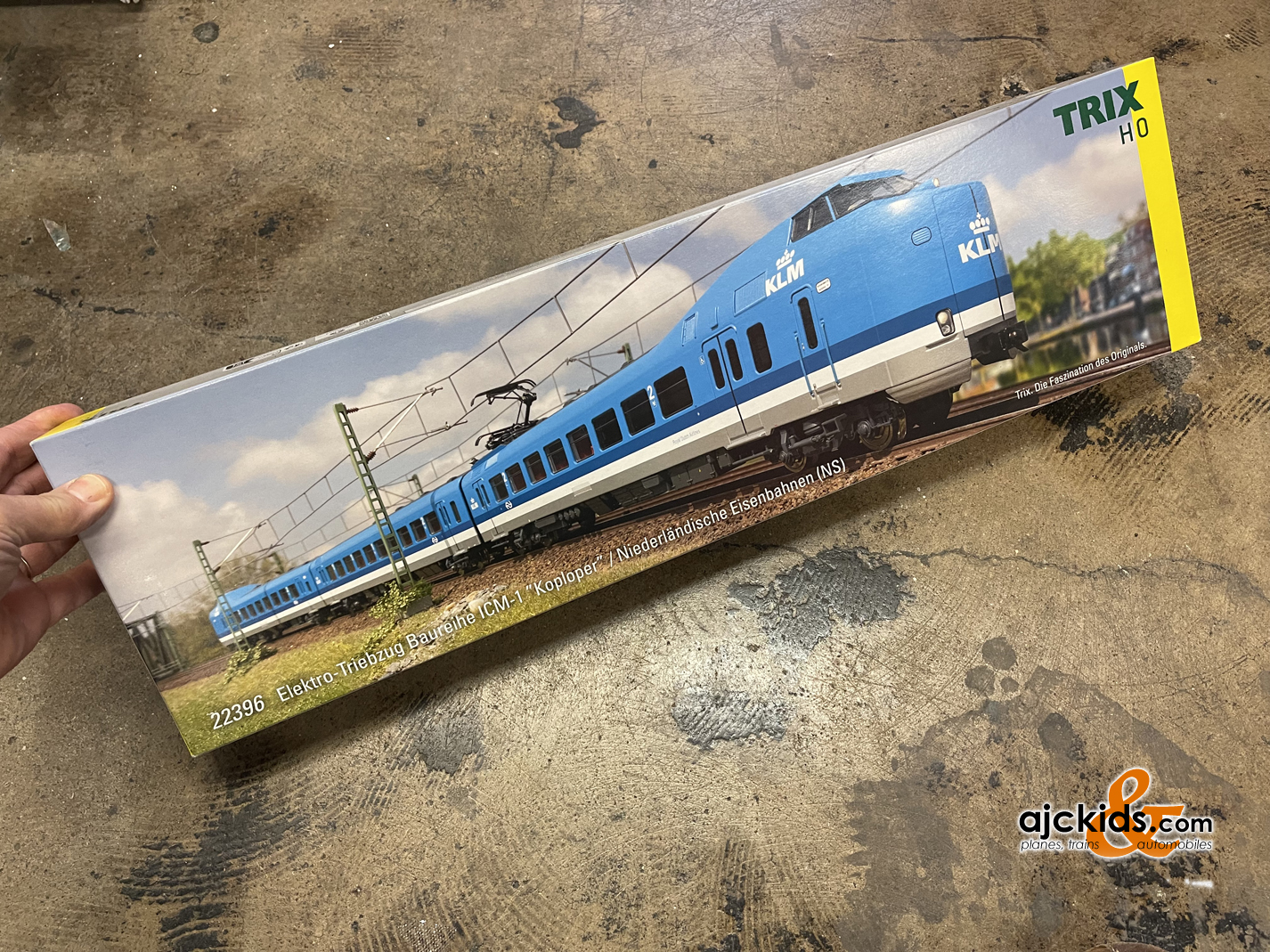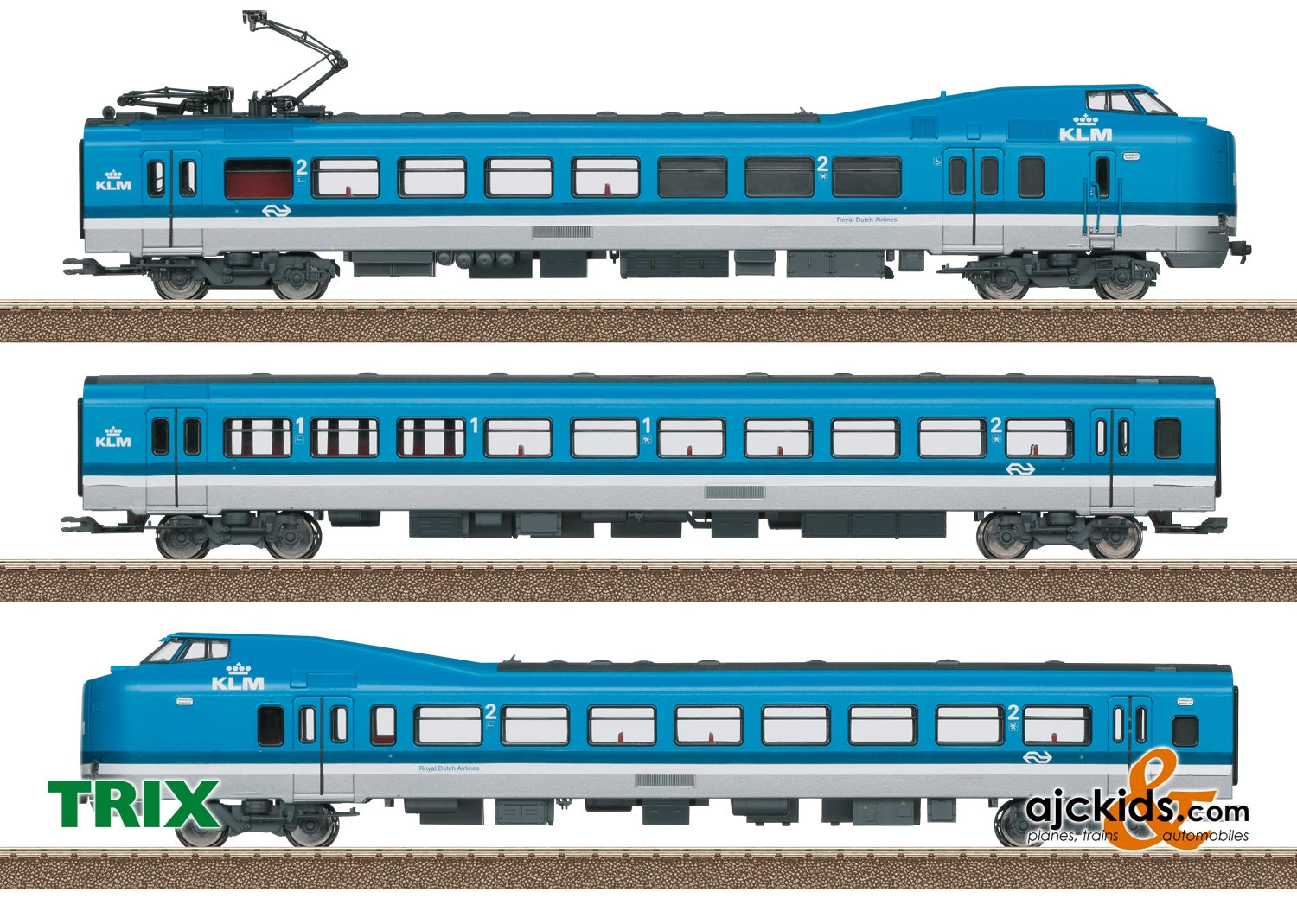Trix 22396 - Class ICM-1 Koploper Electric Rail Car Train
Prototype: Dutch State Railways (NS) "Koploper" three-part electric rail car train as class ICM-1 Intercity powered rail car train. Version in a KLM paint design. 1 motor car as a type mBk end car, 2nd class, 1 type AB intermediate car, 1st/2nd class, 1 type sBk cab control car as an end car, 2nd class. Road number 4011. The train looks as it did around 1986/87
Highlights
- Factory-installed interior lighting.
- RailCom-capable DCC/mfx digital decoder and extensive operation and sound functions included.
- Train destination sign: Amsterdam CS, Schiphol.
Product description
Model: The Trix 22396 - Class ICM-1 Koploper Electric Rail Car Train has a digital decoder and extensive sound functions. It comes in a 3-part version. The powered end car has a die-cast frame. The train has controlled, high-efficiency propulsion with a flywheel. 2 axles in one truck powered. Traction tires. The engineer's cabs in both end cars have interior details. The train has power pickup in the end car at the front of the train; the power pickup changes with the direction of the train. It also has special close couplers with a guide mechanism. The train has factory-installed interior lighting. The triple headlights and dual red marker lights change over with the direction of travel. They and the interior lighting will work in conventional operation and can be controlled digitally. The headlights at car ends 2 and 1 can be turned off separately in digital operation. Prototypical light yellow and red LEDs are used for the headlights and marker lights. Warm white LEDs are used for the interior lighting.
The construction of the running gear and the bodies is detailed. There is a representation of the "Scharfenberg" coupler with a cover on the end cars. A rigid drawbar coupling is included for multiple unit operation. The end cars come from the factory with closed crossover doors. A plug-in part included with the train makes it possible to represent swinging doors with a diaphragm pushed to the side on one end car.
Total train length 86.6 cm / 34-1/8".
Charlie's Tips
This model can be found in an AC version in the Märklin H0 assortment under item number Marklin 37424.
Publications
- Sommer-Neuheiten H0 2023
Prototype information
In 2019, the "Royal Dutch Airline Company" celebrated its 100th anniversary and was thereby the oldest airline company in the world in operation. Even before its formation on October 7, 1919, Queen Wilhelmina had conferred the title "royal" on September 12, 1919 on the still officially unlisted airline company. This is how the firm started by Albert Plesman and known then as "Koninklijke Luchtvaart Maatschappij voor Nederland en Koloniën" (KLM) came into being on October 7, 1919 in aviation history. The first KLM flight went on May 17, 1920 from London-Croydon to the airport at Amsterdam-Schiphol. As early as 1926, KLM was flying from Amsterdam to Bremen, Brussels, Copenhagen, London, Malmö, Paris, and Rotterdam. Regular intercontinental flights to Indonesia started in 1929 and transatlantic flights to the Dutch Caribbean started in 1934. To be sure, aviation service in Europe was dormant during World War II, but in the Dutch Caribbean, flights went on at a lively pace.
On May 31, 1946, KLM was the first continental European airline company to start service to New York. On May 5, 2004, KLM was merged with Air France to make AIR FRANCE KLM Group, with headquarters in Paris. Yet both KLM and Air France kept their independence externally after the merger.
Indeed, the NS painted two class ICM-1 trains in the colors of two Dutch airlines in 1986 not for the 100th anniversary but for the opening of the rail line between Amsterdam Central and the airport in Schiphol. It was a nice coincidence that the ICM units with their raised cab at the front looked a little like a Boeing 747. Road number 4011 gleamed then in the blue-white-gray KLM paint scheme and road number 4012 was in white with red stripes such as the colors of Martin Air.
The ICM trains came about because of the NS desire to purchase new rolling stock for their fast intercity services. These new trains had to be flexible in use with faster, easier separation and coupling at junction stations as well as the option for passengers to change from one unit to the other during transit. With these requirements, the engineer's cabs were thus quickly raised up one level and these powered rail cars were equipped with crossovers at the ends. This feature gave the trains a brawny, unusual look quickly resulting in the nickname "Koplopers" (= Head Runner).
In 1977, the NS initially purchased an advance series from Talbot in Aachen of seven three-part units (4001-4007) as IC3 (later ICM-0). Regular production as the ICM-1 began in 1983 with numerous improvements. Starting with road number 4051 chopper control was added and the class changed to ICM-2. Between 1990 and 1994, 50 four-part units were built as the ICM-3 (4201-4230) and ICM-4 (4231-4250). In contrast to the three-part trains with only one powered end car, on these trains the truck on the intermediate car just behind the powered end car also had powered wheel sets. The mechanical part of all "Koploper" trains came from Talbot, while CEM Oerlikon and Holec were responsible for the electrical equipment. The ICM regular production trains 4011–4097 and 4201–4250 were successively modernized as the ICMm in the years 2006 to 2011. The characteristic diaphragms between the units were left off due to infrequent use. The interior space was completely renovated, wheelchair-compliant restrooms were installed, air conditioning and passenger information displays were retrofitted, and seating was increased by 13%.
Features
Warning
| DCC | SX2 | SX | MFX | |
|---|---|---|---|---|
| Headlight(s) | X | X | ||
| Interior lighting | X | X | ||
| Locomotive operating sounds | X | X | ||
| Horn | X | X | ||
| Direct control | X | X | ||
| Sound of squealing brakes off | X | X | ||
| Headlight(s): Cab2 End | X | X | ||
| Stat. Announce. - Dutch | X | X | ||
| Headlight(s): Cab1 End | X | X | ||
| Doors Closing | X | X | ||
| Conductor's Whistle | X | X | ||
| Pantograph Sounds | X | X | ||
| Rail Joints | X | X | ||
| Train announcement | X | X | ||
| Letting off Air | X | X | ||
| Switching maneuver | X | X |
EAN/UPC: 4028106223969









